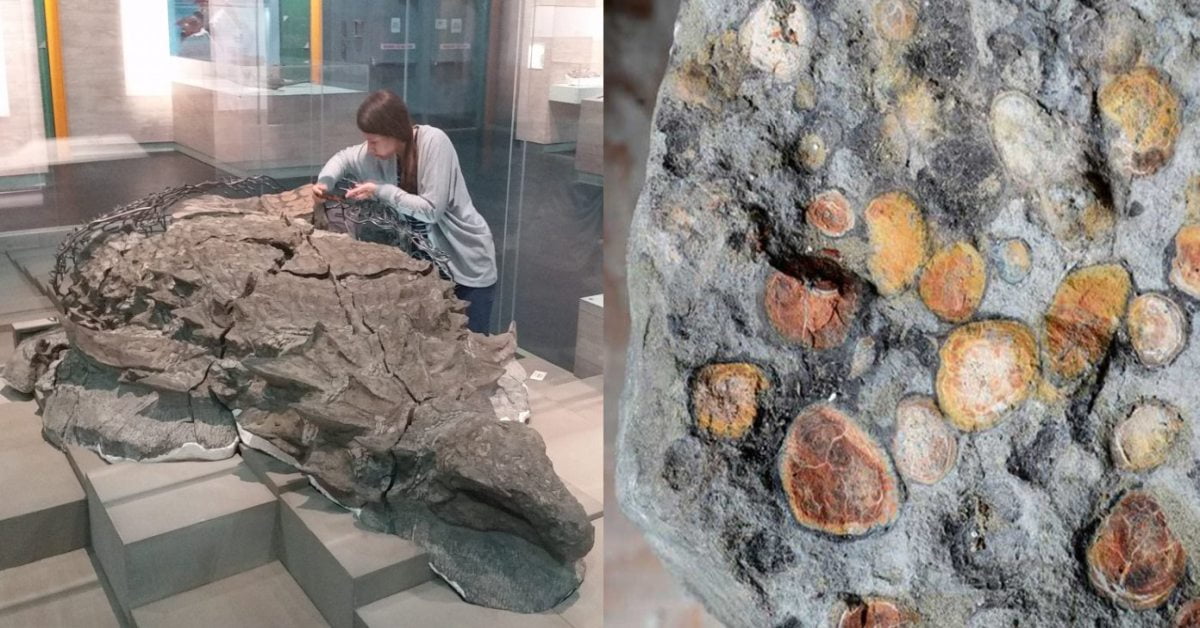About 110 million years ago, a giant plant-eating nodosaur gobbled down its last meal on Earth. Against all odds, its stomach has been preserved so well that scientists have now been able to determine what, exactly, that last meal was.

A team at Brandon University in Canada have become the first researchers in the world to study the actual stomach contents of a dinosaur, more than 100 million years after it ate its last meal. Their findings were published in the journal Royal Society Open Science in June 2020.
Dug up accidentally by miners in northern Alberta, the nodosaur specimen in question is the best-preserved dinosaur ever discovered – even the patterns are still visible on its skin (you can read our article on the discovery here). Because of that, scientists reckon we can safely call it a “dinosaur mummy,” instead of a “fossil.”
And apparently the “dinosaur mummy” was a bit of a picky eater.

Mark Mitchell, a technician at the Royal Tyrrell Museum of Palaeontology where the dino is on exhibit, spent over 7,000 hours carefully unearthing the dinosaur’s preserved skin and bones from the marine rock in which it had been encased. His efforts revealed a soccer ball-sized chunk of material left in the nodosaur’s stomach.
“The leaf fragments and other plant fossils were preserved down to the cells,” David Greenwood, a biologist at Brandon University and co-author of the study said.
The nodosaur, or Borealopelta markmitchelli, was an huge armored giant that could easily weigh over a ton. Despite its massive weight, however, it was a strict herbivore. And based on its stomach contents, its favorite vegetation was most likely ferns.

After comparing its stomach contents with fossil leaves from the same time period and territory, researchers concluded the nodosaur was a picky eater and preferred the soft leaves of certain types of ferns.
“The lack of horsetails and rarity of cycads and conifers is surprising, given that these are very common in the surrounding flora,” Caleb Marshall Brown, curator of dinosaur systematics and evolution at the Royal Tyrrell Museum of Palaeontology said. “Even within ferns, it looks like Borealopelta may have had a preference for certain types of ferns while ignoring others.”
In total, researchers found 48 microfossils of pollen and spores, moss and liverwort, 26 club mosses and ferns, two flowering plants, and 13 conifers. And they also found something else.

Apart from food, there were pieces of charcoal in the nodosaur’s stomach. This turned out to be consistent with its time period, as forest fires were a common occurrence during the early Cretaceous period and ferns, which were low to the ground, could survive. And, according to researchers’s estimates, a fire had indeed ravaged the grazing area of the nodosaur about six months before it ate its last meal in the spring or summer.
“The discovery of charcoal together with a fern-filled stomach… suggested Borealopelta was likely a keystone herbivore that shaped the landscape by its grazing, and that it also grazed on the ferns growing in open areas created by wildfires,” Greenwood said. “That is so cool.”

“The discovery of a specimen like this is absolutely remarkable, and the preservation of the plant fragments is evidence that it died shortly after its last meal,” he added.
A perfectly preserved last meal from 100 million years ago in a perfectly preserved dinosaur… Well, nature is incredible.
Read more about the “dinosaur mummy” here.
